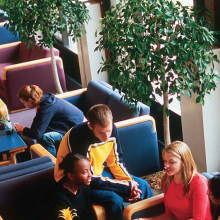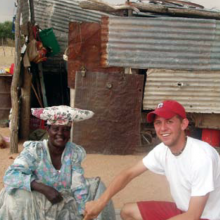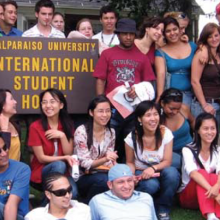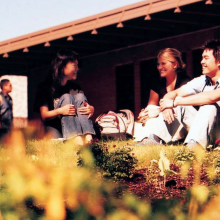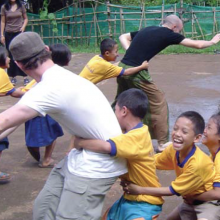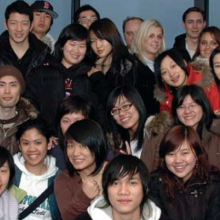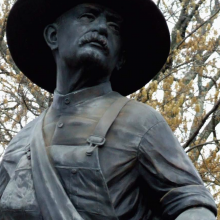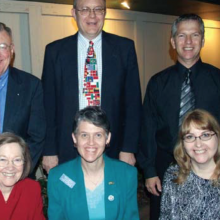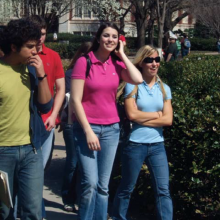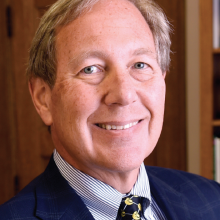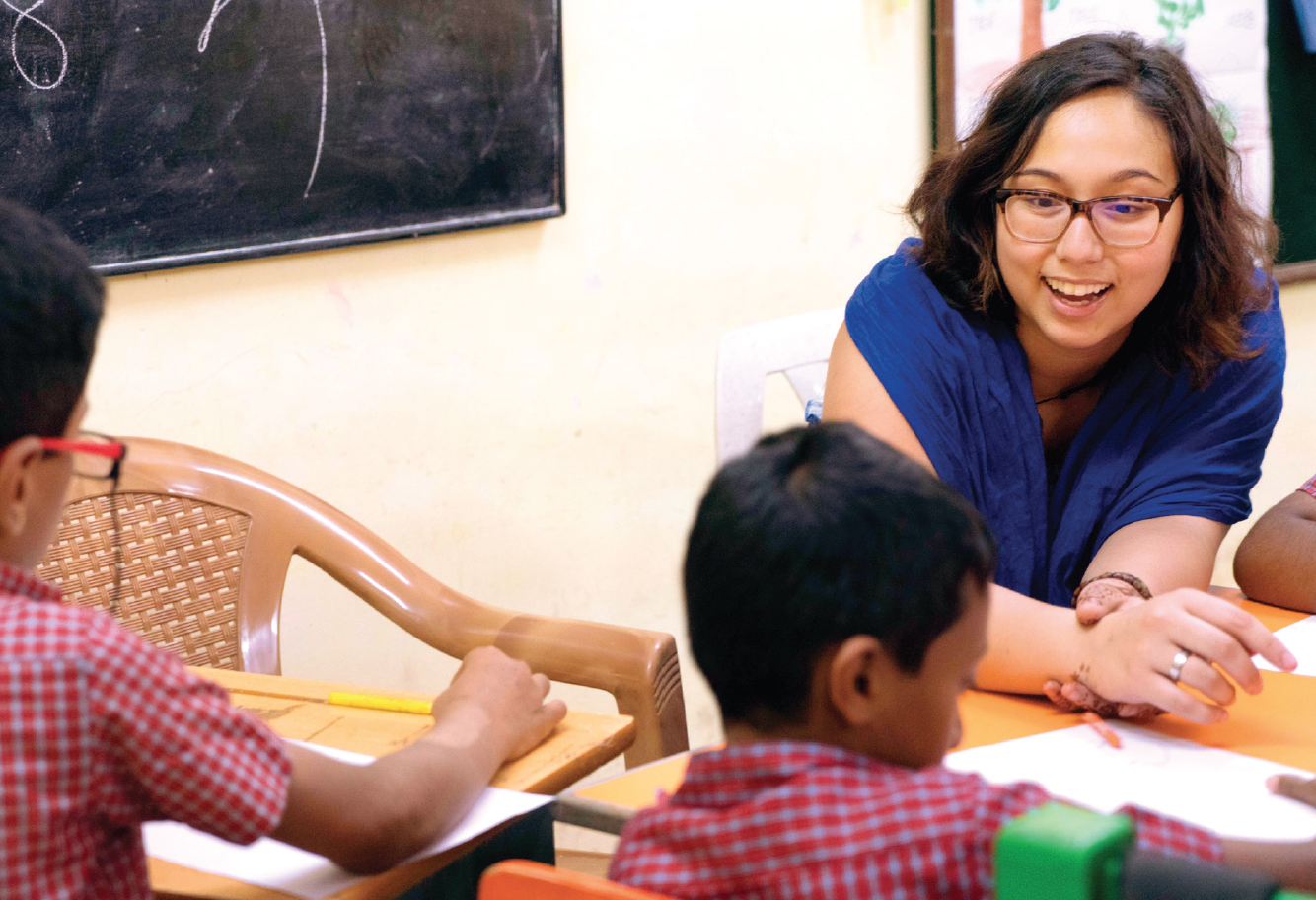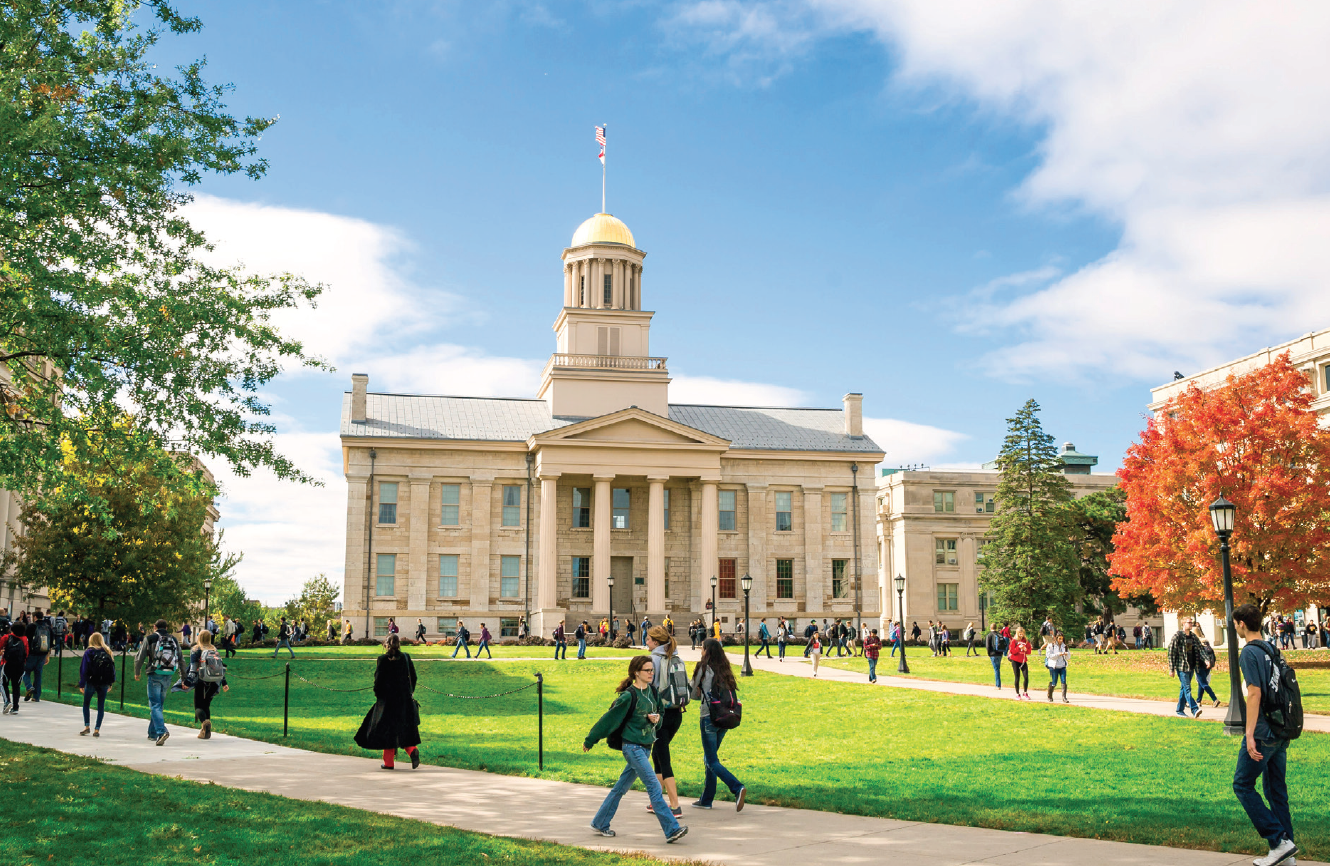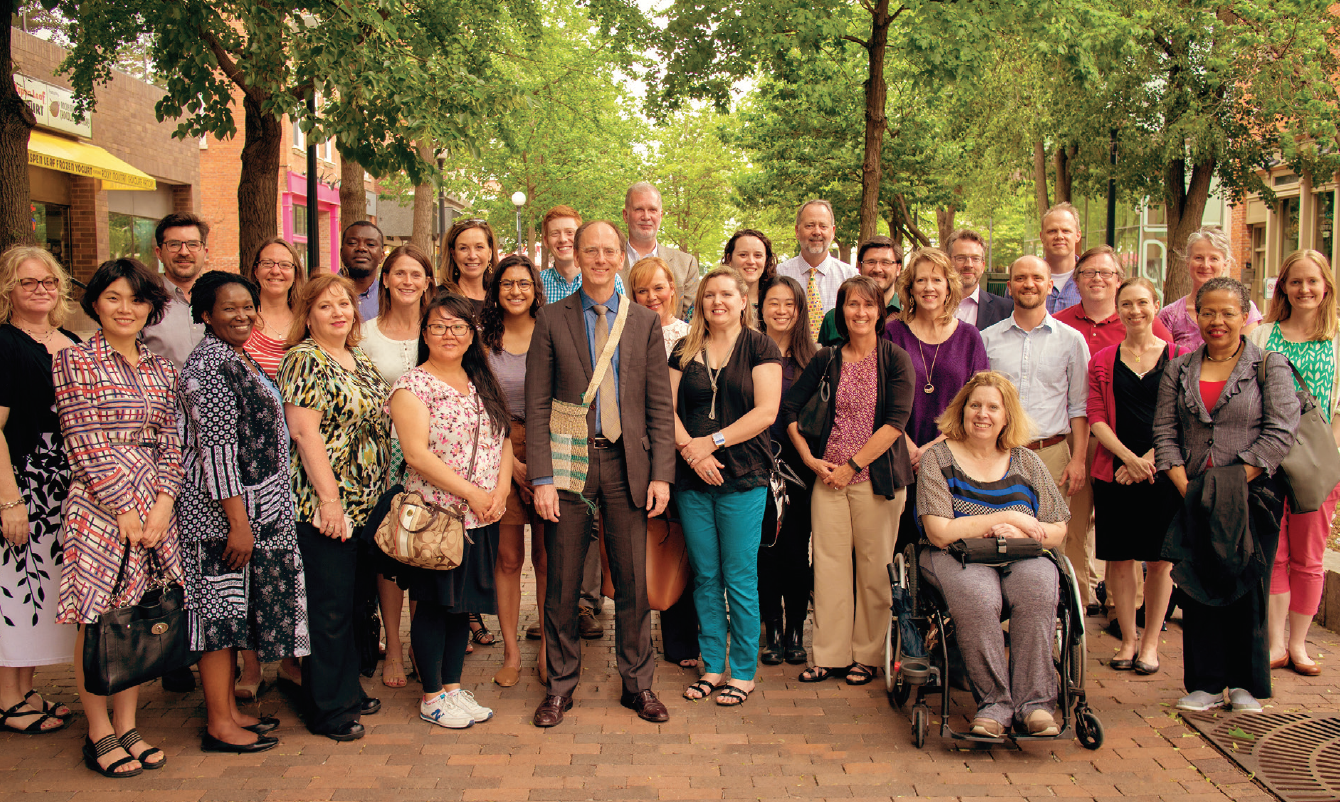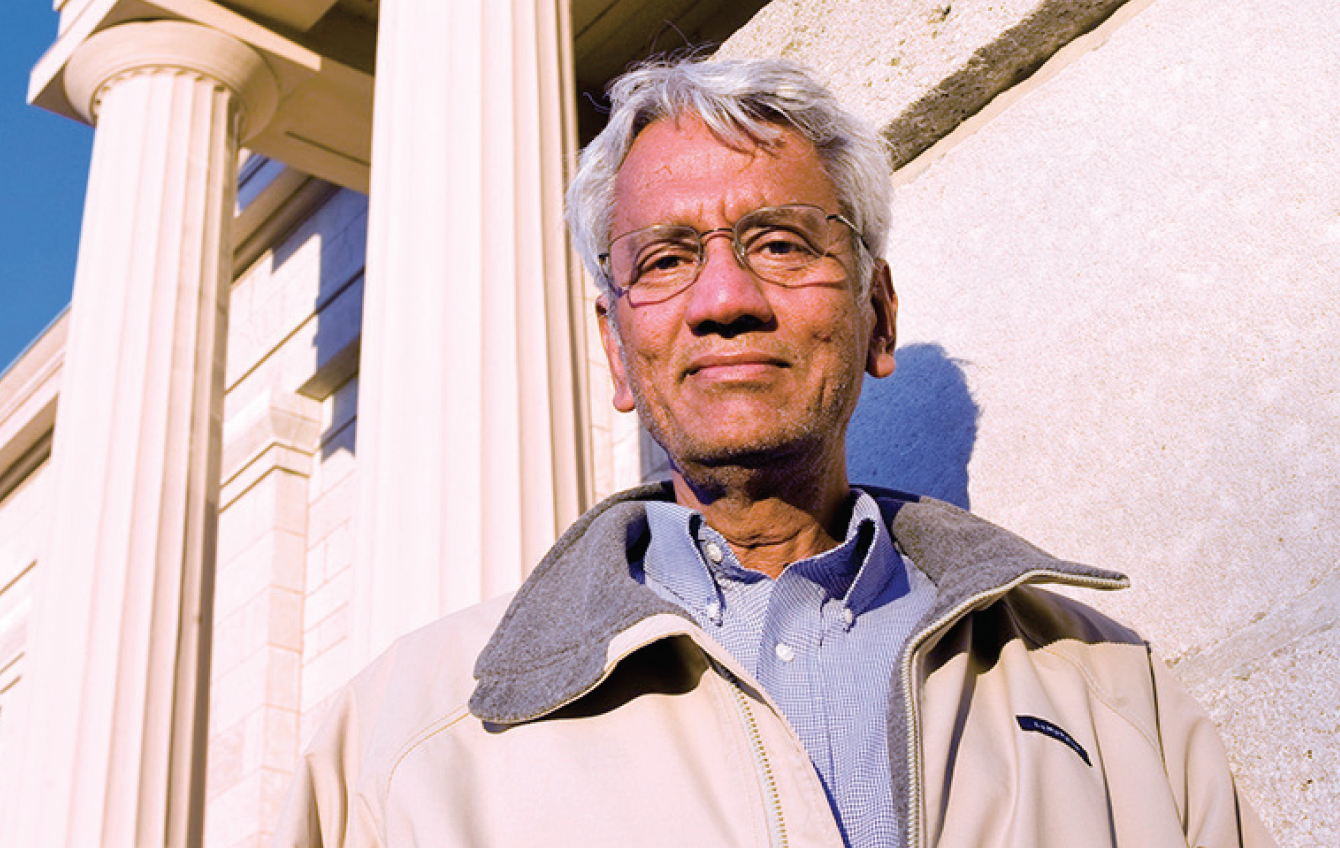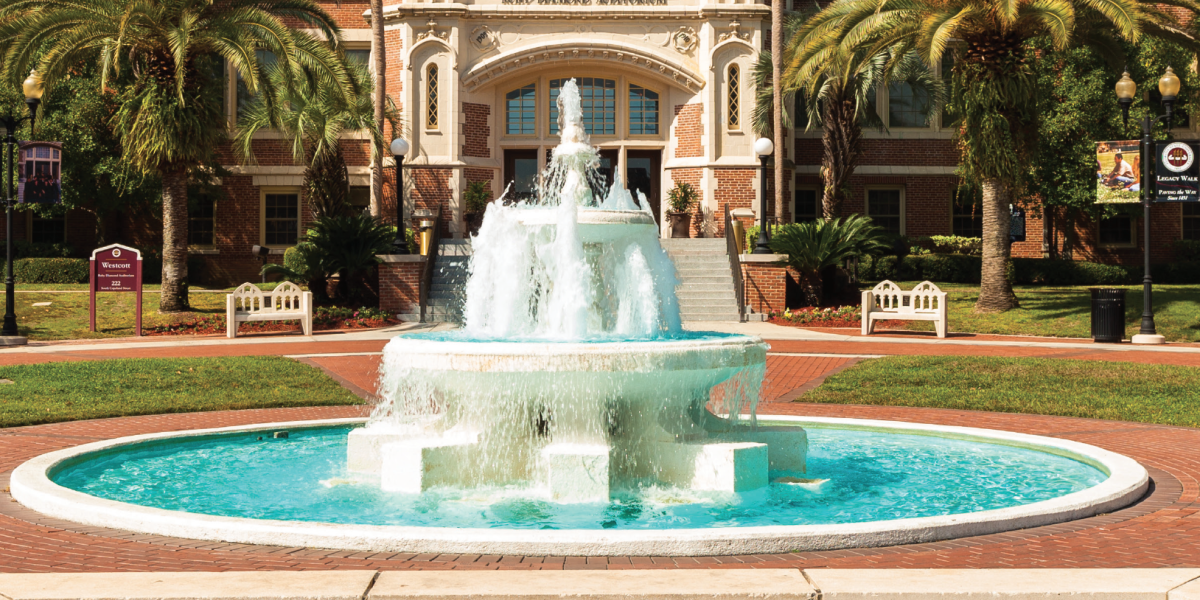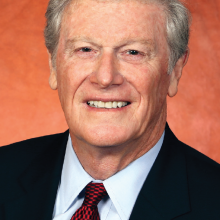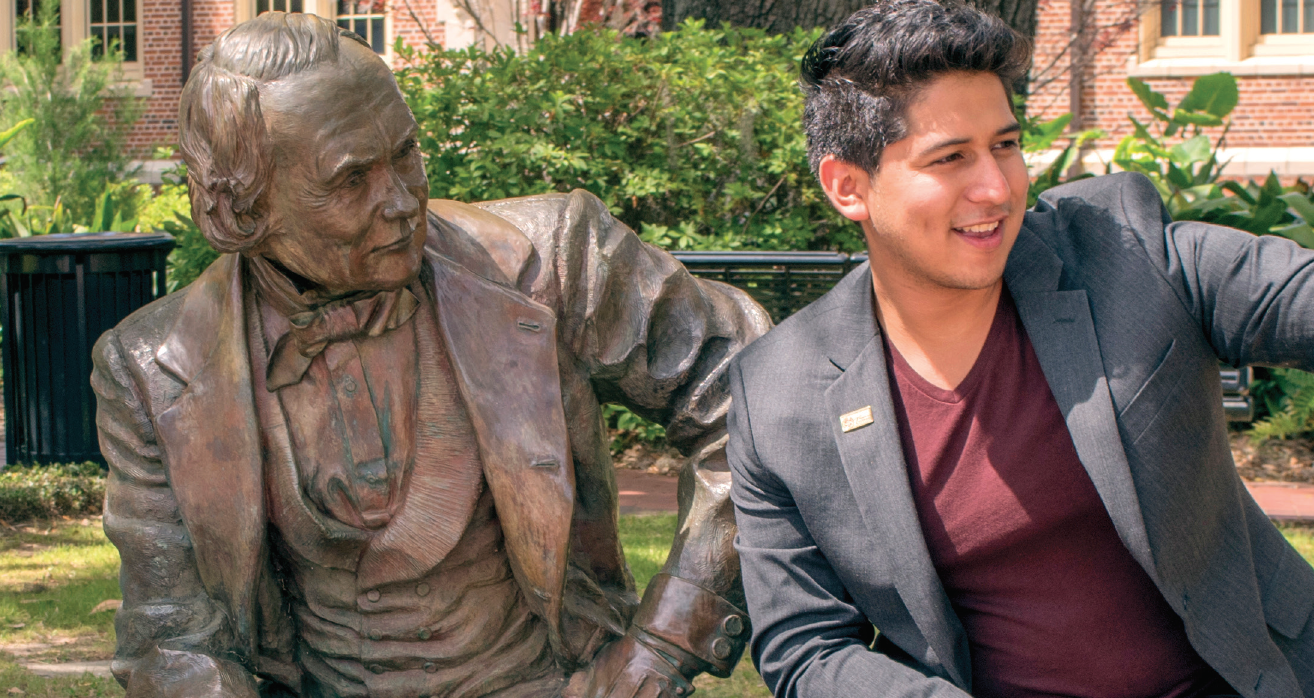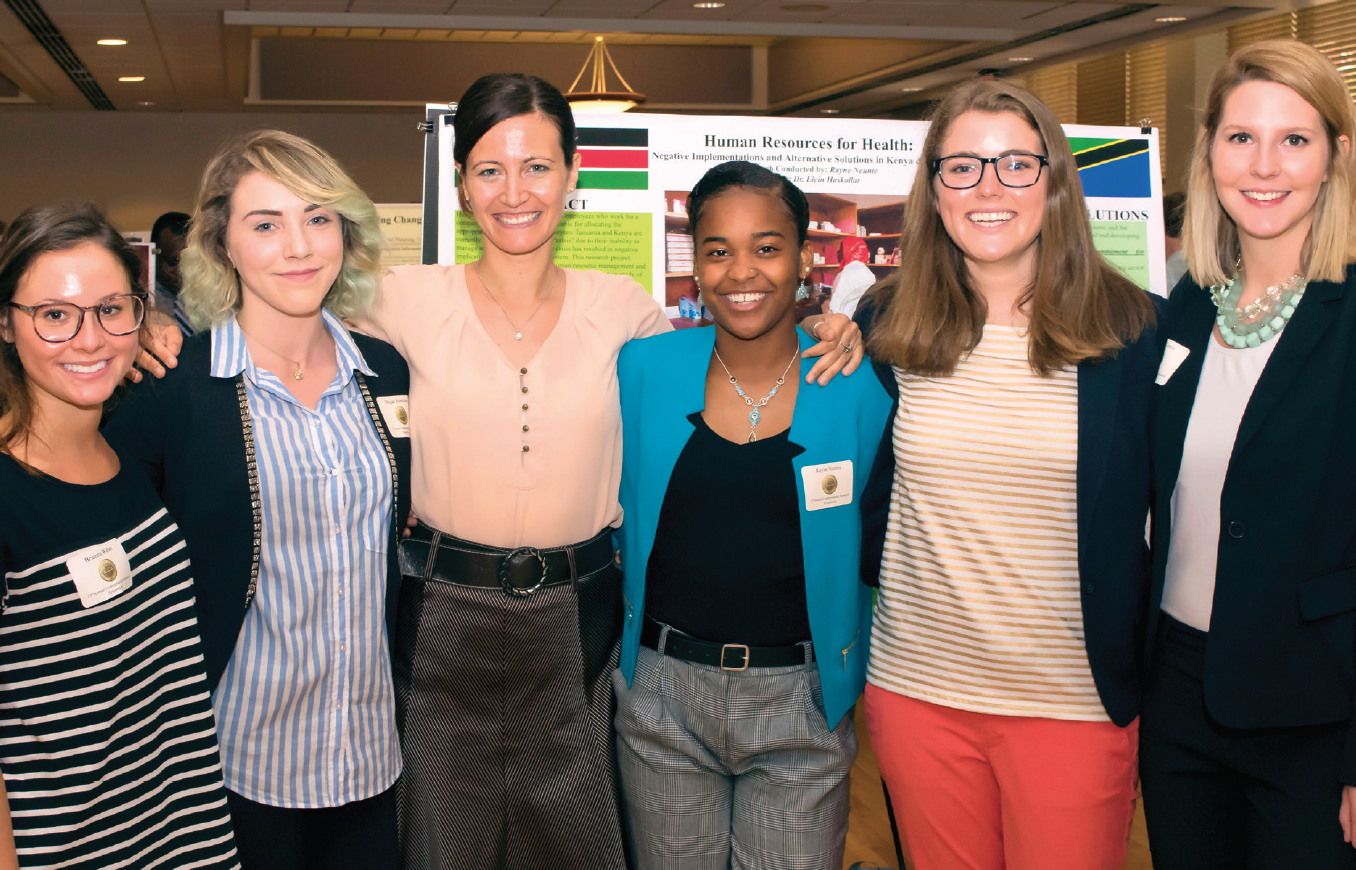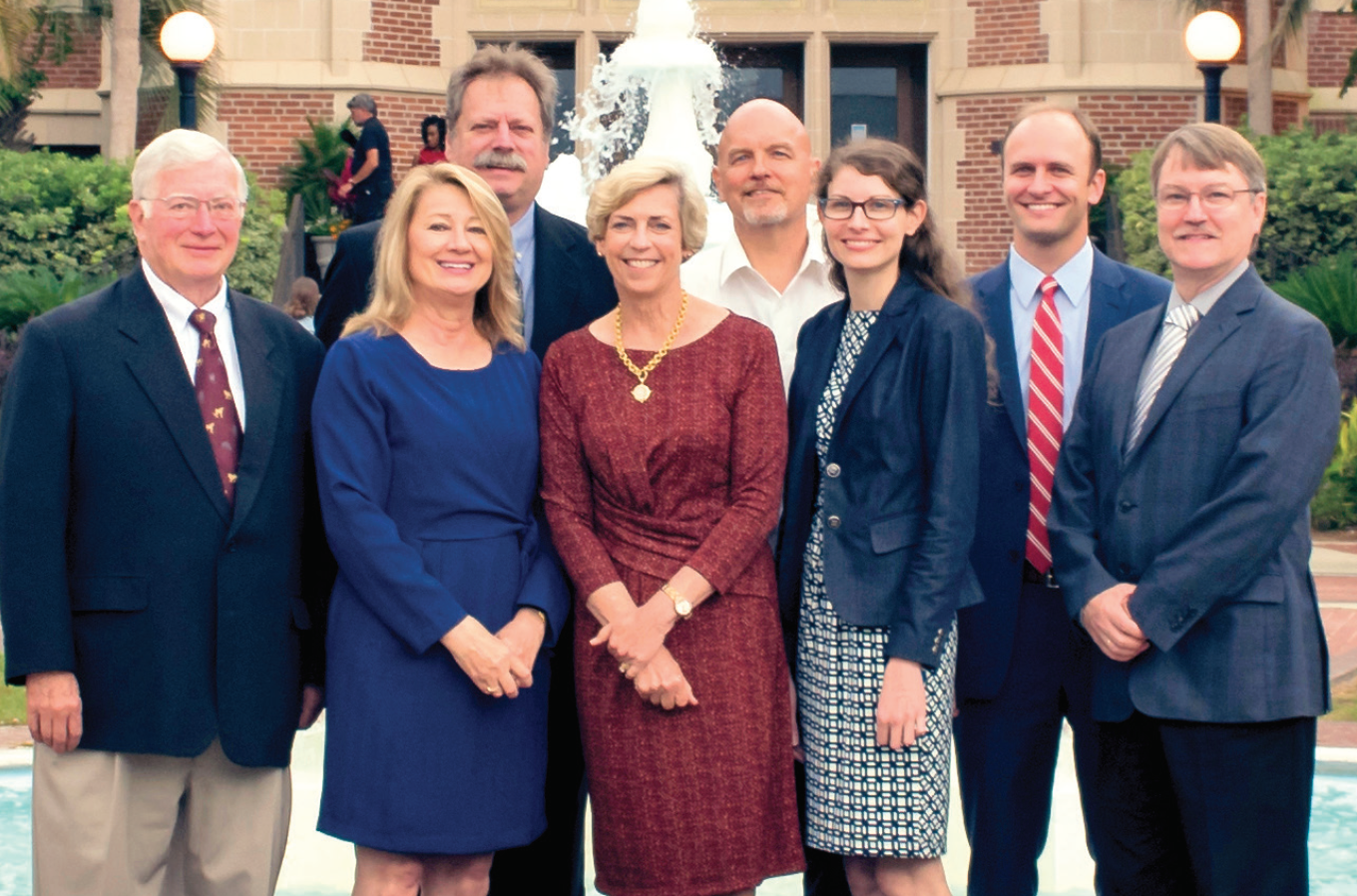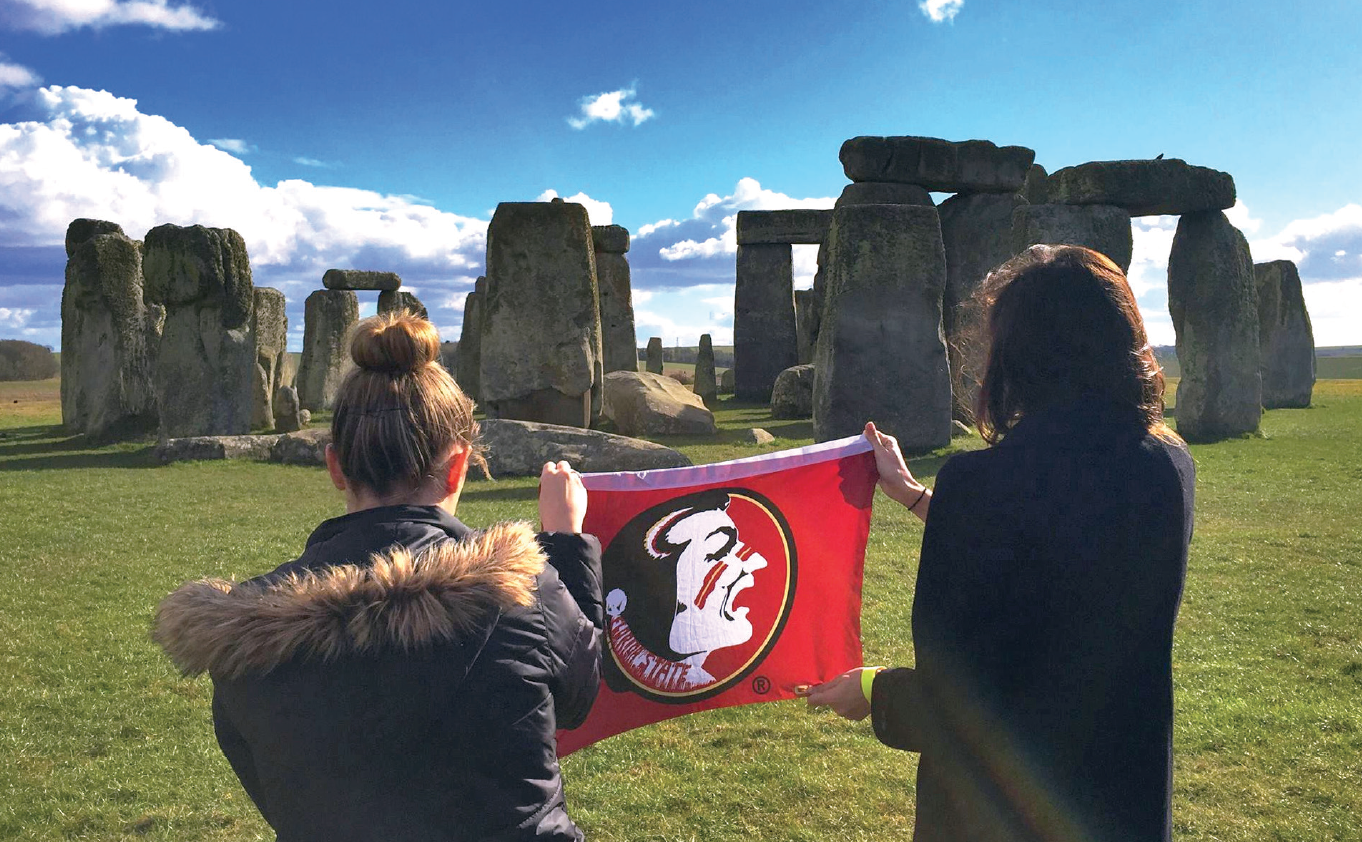Program Development and Delivery
Education Abroad: Critical Skills for the Adviser
Collaborative Approaches to Developing Faculty-Led Programs
2007 Spotlight Valparaiso University
There is no ice hockey team at basket-ball-crazed Valparaiso University, but the Indiana institution completed a hat trick this spring when for the third time in four years a trio of seniors was awarded Fulbright scholarships. They are bound for China, South Korea, and Germany. For a campus with 3,000 undergraduates, it was evidence how successful the 148-year-old independent Lutheran school has been in infusing the curriculum with international content and encouraging students to explore global issues. Valparaiso sends upwards of 200 students a year to study abroad, many to programs it operates in Cambridge, England; Reutlingen, Germany; Puebla, Mexico; and Hangzhou, China. It requires nearly all freshmen—including nearly 1,000 business, engineering, and nursing majors—to take a two-semester, interdisciplinary course that meets five hours a week to discuss texts from the East Asia and Afghanistan, from Plato and Sophocles, and from the Old and New Testaments of the Bible (the 80 freshman in the honors program, Christ College, read equally diverse and global texts).
One of the latest Fulbrighters, Carl Boschert, a Chinese and Japanese studies and history major from Jackson, Mississippi, spent a semester at Valparaiso’s Hangzhou Study Center and made two other research trips to China. Associate professor of history Charles Schaefer, who advises the Fulbright applicants, sees “a direct correlation between our students’ performance in winning Fulbright awards and our overseas study programs. Many of our students have studied overseas for a semester or an entire year and come back with an expanded world view and an interest in exploring international studies even further.” Schaefer himself as a Fulbright lecturer at Addis Ababa University in the 1990s.
Religious and classical music occupy an important place in the life of Valparaiso. A $1.5 million gift allowed it to open a Bach Institute in 2003, and the university chorale has toured Germany twice in recent years and performed as a resident choir in Leipzig at St. Thomas Church, where Johann Sebastian Bach was cantor for the last 27 years of his life and where he is buried.
The Valpo Core Course Leads Internationalization
“We provide a lot of opportunity within a small-size liberal arts college,” says Provost Roy Austensen. “We provide a liberal arts education for engineers and accountants and finance majors and nurses as well” as arts and science majors (Valparaiso’s law school, which dates back to 1879, enrolls 500 students; 400 other graduate students pursue degrees in arts and sciences, business and nursing). John R. Ruff, associate professor of English and director of the Valpo Core Course, describes it this way:
Since its inception in 1998 the Valpo Core has helped to broaden and internationalize Valparaiso University first-year students’ horizons. Almost every unit in this year-long course puts into dialogue texts from different eras and traditions: Gilgamesh with Genesis , Shusako Endo’s Silence with the Gospel of Mark, Lord Shang and Mencius with Plato and John Stuart Mill, The Bhagavad Gita with Martin Luther’s Christian Liberty . Laura Esquival’s Like Water for Chocolate transported us to Mexico during the Mexican Revolution; Julia Alvarez’s In the Time of the Butterflies took us to the Dominican Republic during the Trujillo era; Philip Gourevitch’s We Wish to Inform You That Tomorrow We Will Be Killed With Our Families brought us to Rwanda after the genocide. Khaled Hosseini’s The Kite Runner , set mostly in Afghanistan, has been one of our most successful texts; Il Postino and Cinema Paradiso , set in Italy, are among our most successful films. This past year Sonia Nazario’s Enrique’s Journey helped us put a human face on the undocumented worker traveling by train from Honduras into the United States, a harrowing and heartbreaking tale.
Gourevitch and Nazario have spoken on campus, and Elias Chacour, the Palestinian peace activist and priest whose autobiography Blood Brother was just added to the syllabus, has been invited.
Valparaiso draws a third of its students from Indiana and almost as many from Illinois and elsewhere in the Midwest. The campus is located an hour outside Chicago and 15 miles south of Lake Michigan and the 15,000-acre Indiana Dunes National Lakeshore. International students numbered 118 in 2006. With a 13-to-1 ratio of students to faculty, Valparaiso prides itself on keeping classes small. To keep each of the 40 sections of the Valpo Core Course under 20 students, the university encourages every department except engineering to contribute faculty, and most do. “The beauty is that the core stimulates a conversation about major ideas and themes in human history among a wide variety of faculty members, some of whom haven’t touched texts like these since they were undergraduates themselves—if then,” says Austensen, whose field is modern European history. “It enlivens the intellectual climate of the campus.”
Before the Valpo Core, there was a required freshman seminar, but the topics and syllabi varied widely. Jon T. Kilpinen, dean of the College of Arts and Sciences, says, “As a residential campus, we felt that building a common experience among the freshmen was important. It would assist with retention but also help build a sense of community and identity for each group of students.” The Valpo Core looks at themes of life, death, vocation, loss, and love through the lens of great works of literature and art. Many texts are ancient classics, but others explore modern dilemmas, such as Tracy Kidder’s gripping Mountains Beyond Mountains on Dr. Paul Farmer’s fight against poverty and infectious diseases in Haiti and globally.
Associate Provost Renu Juneja, who joined the faculty in 1978 after coming to the United States from India on a Fulbright scholarship, said teachers from different fields come together as cohorts to discuss the texts before teaching them to the students. “What has developed is a mathematician sitting with a nurse sitting with a historian sitting with an English professor sitting with a chemist, and the conversation that takes place among these people before they even go to teach has in some ways transformed the experience for our students,” says Juneja, a professor of English.
Hugh E. McGuigan, director of International Studies, is convinced the freshman Core whets student appetites for study abroad. Valparaiso is a founding member of the Associated New American Colleges (ANAC), formed in 1994 by a group of mid-sized, comprehensive universities that emphasize undergraduate education and offer master’s and professional degrees. Elon University, a 2007 winner of the Senator Paul Simon Award for Campus Internationalization, also belongs to the group of 22 institutions, which allows members to send students on each other’s study abroad programs at no additional cost. “We’ve got a student now studying in Morocco through Mercer University, and we had two in the fall through Butler’s program in Alcalá, Spain. We have another student in Puebla, Mexico, through Ithaca College. This ANAC consortium is giving us more study abroad opportunities in countries where we don’t have our own programs,” says McGuigan, who has been at Valparaiso since 1983.
The Fifth Hour—A Movable Feast
The most unusual feature of the 10-credit Valpo Core is the fifth hour each week that takes place outside the classroom. “In some ways it’s a moveable feast. A variety of activities take up that fifth hour. The residential life people on campus have become very involved with the Core,” says Dean Kilpinen. “Since our freshmen live together, the student affairs people do programming in the residence halls that matches the syllabus. Likewise, our art museum also follows the syllabus.” The museum displays works of art that relate to the topics under discussion in a special room.
The activities and the undertakings vary, and not everybody must do the same thing. “If there’s a German film festival on campus, that could be a core-approved activity, or a jazz festival, or our Martin Luther King Day celebration,” says Juneja. Students must write about their activities—the Valpo Core is a writing-intensive experience—but no one scans IDs at the door.
Mel W. Piehl, professor of humanities and history and dean of Christ College, notes the honors college has incorporated classic Chinese and Japanese texts and East Asian issues into its freshman curriculum. “Students regularly read Mencius, Chuang-Tzu, Hsun-Tzu, Lu Xun, and other classical and contemporary Chinese thinkers,” says Piehl, a 1968 alumnus. And the college provides “Albert Schweitzer Fellowships” for students to work as medical volunteers in mobile clinics in Costa Rican and Nicaraguan villages over Valparaiso’s two-week spring break.
Sending New Faculty Abroad
Valparaiso also sends new faculty after their first year off to Cambridge, England, for a week-long retreat. They live in apartments that Valparaiso students occupy in the fall and spring, see shows on London’s West End and visit the usual sights, but they also learn firsthand just how much importance Valparaiso places on international education. “Part is acculturating them to the special mission of this university and part is helping them bond with each other as a cohort so they are not in their silos. But part is also to widen their horizons,” says Juneja. “However much we say that England is like America, it’s really another strange country for most Americans.” In summer 2006, the entire Christ College faculty traveled to Berlin, Leipzig, Wittenberg, and Erfurt, Germany, for 10 days; other faculty have traveled as a group to China.
International Presence on Campus
When Juneja and her husband, political scientist James L. Kingsland, joined the faculty in 1978, she found herself one of the few international professors on campus and one of only a handful of people from India in the community. Now, almost two dozen of Valparaiso’s 254 full-time faculty is international. “It’s changed so much,” she says. “I remember when there were only four or five Indian families in the surrounding area, and now we can’t find a hall to accommodate us all. We built a cultural center 15 miles from here and this is happening in other communities as well. I am a Sikh and we built our own temple. I just find the whole situation has changed dramatically.”
International enrollments actually peaked in the late 1990s before Asian enrollments dropped after a currency crisis, and fewer students from the Middle East came after the September 11, 2001, attacks on the United States. “But the trend now is going back up,” says McGuigan, especially with the government of Saudi Arabia funding scholarships for its nationals to study in the United States.
“We are going about this much more deliberately,” says Juneja. “When I came there was no concerted effort made to recruit students internationally. It was personal contacts and church connections that brought us students. It’s only in the last 15 years that we’ve actually done international recruiting.” At first Valparaiso was content to send a representative on tours to college fairs in Asia, the Middle East, and Latin America. Now it is lining up exchanges with partner universities in China and elsewhere. Holly Singh, assistant director of international programs, also has made several recruiting trips to India, his homeland.
“We have partnerships now with five Chinese universities. They send us students … and we host their faculty for professional development. Many Chinese faculty have come here for a semester,” says Juneja. Almost five dozen professors from Zhejiang University in Hangzhou—where VU’s own study center is located—and other universities in China have been visiting scholars at Valparaiso. Using its religious connections, Valparaiso also hosts young faculty from overseas who are sent to the Indiana campus for four months of mentoring by the United Board for Christian Higher Education in Asia. Eighteen professors early in their careers have made that journey over the past four years from institutions in China, India, the Philippines, Taiwan, Thailand, Cambodia, Vietnam, and Indonesia. McGuigan said that one participant, a professor of English from Nanjing University, “just fell in love with Valpo” and immediately recruited four students to come to Valparaiso for master’s degrees in international commerce and policy, as well as English and communications.
A former president, O.P. Kretzmann, once defined religious universities such as Valparaiso as places “where Athens and Jerusalem meet.” Nowadays, Valparaiso is adding other cities across Europe, Asia, and Latin America to that mix, and Valpo’s students are the better for it.
Valparaiso University
2007 Spotlight Shoreline Community College
When Shoreline Community College was built in a Seattle suburb 10 miles from the Space Needle in 1964, the wooded, 83-acre campus was designed to look like a Japanese botanical garden. The student union, the PUB, was an acronym for Pagoda Union Building, and until the 1990s its sports teams competed as the Shoreline Samurai. That nickname was abandoned after student leaders decided it was demeaning, and today Shoreline athletes take the field as the Dolphins.
But Shoreline itself is more international than ever, with a record 643 international students enrolled in 2006-07 and scores of students along with faculty studying overseas each summer. Many of these ambitious programs were spawned by an initiative the college took in 2001 when it created an International Programs Advisory Committee (IPAC) with an annual purse of $20,000 to disburse grants to faculty to develop short-term study and service abroad projects. That next summer, faculty led dozens of students on three-week study trips to Antigua, Guatemala; Monterrey, Mexico; and London, England. Every summer since then, 45 to 70 Shoreline students have headed off to earn credit in China, Japan, Ireland, Greece, Turkey, Namibia, South Africa, Thailand, Honduras, Peru, Argentina, Iceland, and elsewhere.
Through Shoreline’s membership in the Washington Community College Consortium for Study Abroad, students also can take classes during the fall, winter, and spring in London, Florence, Paris, Salamanca, and San Jose, Costa Rica. From 1999 through 2006, 120 Shoreline students studied abroad through the consortium, and three Shoreline professors taught classes overseas.
In a region replete with excellent community colleges, Shoreline must scramble for students, despite its excellent track record in sending graduates to the University of Washington for four-year degrees. The commuter college, two miles inland from Puget Sound, is the tenth largest of Washington’s 34 community colleges. In addition to awarding associate degrees in arts and sciences, it prepares students for careers in health, technology, and computers and has an award-winning automotive training center. Most of the international students who make their way to Shoreline seek to transfer to universities, says Thalia Saplad, executive director of the Office of International Programs. “For international students, business is number 1. Our engineering, health occupation, and nursing programs are also draws, as well as biotechnology.” Many international students come from Asia, with the largest numbers from Indonesia, Hong Kong, Korea, and Japan.
After two presidents departed in four years, Shoreline found stability when civil rights attorney Lee D. Lambert was promoted in 2005 to interim president and later given the job on a permanent basis. Through it all, support from the top for Shoreline’s internationalization was unwavering. The commuter campus earmarked $85,000 in 2005–06 and another $85,000 in 2006–07 toward internationalization projects, including grants for faculty development, study abroad scholarships as well as improved services for international students. “The administration is very supportive of building programs and curricula that prepare our students to be global citizens,” says Saplad.
Praise from Accreditors
The Northwest Association of Schools and Colleges and Universities commended Shoreline in 2002 for “its excellent international studies program.” The visitors left “impressed by the exemplary and creative efforts to recruit and accommodate international students and to use resources from the success of that program to encourage faculty and students to travel and study abroad.”
A 10-person staff works on international programs and advises the growing ranks of students from around the world. “We’ve made a concerted effort in the past several years to integrate our international education programs and our international students with the rest of the campus,” says Saplad. “More and more international students have taken leadership positions in our student government. They hold eight of the 12 executive offices this year.”
International Peer Mentors
Mari Kosin, assistant director of international student services, laid the groundwork for the emergence of international students into leadership positions with a program she started five years ago called International Peer Mentors (IPM). Five students are selected annually for these paid positions, in which mentors help newcomers to the United States adjust to life at Shoreline and in the Seattle area. The mentors take diversity training alongside full-time college staff and help shape both educational and extracurricular activities for their peers.
“They play a major role in our orientation for international students,” says Saplad. “They’ve helped get more international students to partake in activities and to get more involved in their education. They undergo professional development with my staff and we send them to conferences around the state. It’s the first time in years where international students have really seen themselves as part of the institution.”
Colleen Ferguson, assistant director of international education, said the first international students to run for campus-wide office were veterans of the International Peer Mentors program. “They learned a lot about the institution and how it worked. They had the confidence to apply for posts in student government because they had held these IPM leadership jobs for a year,” she says.
An Exploration of Irish Literature and Culture
The International Programs Advisory Committee, which includes two Shoreline students, two staff members, and a broad representation of faculty, sifts through faculty proposals for summer study abroad courses and decides which ones to fund. Gary A. Parks, a professor of English literature and creative writing, received a green light from IPAC to take creative writing students to Ireland in August 2006 to explore the sources of inspiration for W.B. Yeats, James Joyce, and other authors and to craft stories of their own. In addition to viewing the Book of Kells in Trinity College in Dublin and standing before the majestic Cliffs of Moher jutting into the Atlantic off County Clare, they attended a poetry slam at a pub in Galway and worked up sketches about life in nineteenth century, famine-stricken Ireland while visiting Inishmore, birthplace of novelist and activist Liam O’Flaherty.
“The driving query of the class was that I wanted people to explore the question of why such a small nation has produced so much great literature,” says Parks, who has taught at Shoreline for 16 years. Six men and two women, all 21 or younger, signed up for the course, which cost $2,400 plus $600 for meals. Given a choice of taking an introduction to Irish literature or a short story writing class, all opted for the latter, “which simplified things for me and made it a bit more fun,” he says.
He had students read excerpts from Mackin’s 1955 novel, Rain on the Wind. “We did the Yeats pilgrimage to Sligo, and visited Inishmore, an island in the Gaeltacht off the west coast of Ireland,” he says. “A lot of native speakers there still speak Irish. Liam Flaherty’s stories get mystical in places, and when you read them on Inishmore you can really understand how this place would give rise to these stories.”
“It was a great experience,” says Parks. When the students came home, half signed up for an Irish literature course that he inaugurated at Shoreline that fall. “That class filled up with 27 students. It was a nice follow-up in terms of internationalizing the campus,” he says.
Service Learning in Jamaica
One of the most frequent fliers on Shoreline’s faculty is psychology professor Robert B. Thompson, who regularly leads students on a 16-day summer service learning trip to the Blue Mountains of Jamaica, where they volunteer in the schools of a rustic village. Thompson worked as a psychologist alongside the Peace Corps in that same village two decades ago and has returned with students ever since, first while teaching at Rollins College and over the past 13 years at Shoreline.
“It’s a village without electricity only 25 miles from downtown Kingston, but very difficult to get to. We have to go up the mountain by four-wheel-drive truck,” he says. “The students live at the houses of two coffee farmers and work within the community, primarily tutoring in two elementary schools.” Thompson twice has spent six-month sabbaticals in the Blue Mountains and returned to campus in 2006 determined to help the Jamaican farmers secure a niche and better prices in Seattle’s food markets for their rich coffee beans.
“I recruit the students out of my psychology classes,” says Thompson. “They are very diverse. On this summer’s trip, 75 percent have never before traveled outside the Northwest. It’s a unique opportunity for them. I have three students over age 50, several in their 30s and 40s, and students who are 18, 19 years of age.”
Both Thompson and the students find the readjustment upon return to Seattle challenging. “You’re bombarded with the technologies, the lights, noises. Everybody’s in a hurry. Once you get accustomed to a certain rhythm, it’s very difficult to come back and be thrown into another culture,” he says. “The students see their culture and their surroundings in a different way.” Some, he adds, change career paths so they can deal directly with the poverty they saw in the Blue Mountains.
A Commitment to Multicultural and Global Awareness
Thompson, who served on the IPAC for four years, says Shoreline “definitely is an unusual community college. A lot of four-year schools don’t support the type of unique (study abroad and international service) programs we have.”
Parks said the emphasis on the international at Shoreline fits in with its “tradition of being a strong academic transfer school. It’s just part of our history and culture here. We have a commitment to multicultural awareness and global awareness.”
Shoreline’s summer study abroad programs are open to all students and members of the community, although traditionally they have drawn primarily those on track to transfer to a four-year institution. The Office of International Programs now is stepping up efforts to interest more of the students who are seeking technical and professional degrees in study abroad. Two new exchange partnerships have already borne fruit. Last winter, six Danish business students from Erhvervs Akademi Vest (Business Academy West) in Esbjerg, Denmark, came to Shoreline for classes and internships with local businesses, and Shoreline and the Danish institute exchanged business and marketing professors for two weeks. Shoreline has won awards for its automotive technology offerings and this past summer 20 students from Ajou Motor College in Boryeong, South Korea, spent two weeks at Shoreline to kick off a reciprocal student exchange program. Ajou’s program is regarded as one of the finest in its country.
President Lambert, who is Korean-American, summed it up last fall in his first “State of the College” address. “One of the great challenges before us is how we prepare our students, community, and workforce to compete in a global world,” Lambert said. Stressing the importance of the liberal arts to the development of the whole person, he added, “Whether it’s the nineteenth century or the twenty-first century, there are certain skills and talents that are universal from one generation to the next. I am proud to be part of a campus that grapples with these issues as we debate ways to ensure that all of our students receive a world-class educational experience.”
Shoreline Community College
2007 Comprehensive University of Oklahoma
A stranger visiting the University of Oklahoma’s graceful campus in Norman, Oklahoma, who drives down David L. Boren Boulevard, or strolls into the David L. Boren Honors College, or spies the statue of David Boren in a cornice on Evans Hall might assume that Boren led the university during its glory days.
He did—and still does. For the University of Oklahoma, these past 13 years since David L. Boren relinquished a powerful seat in the U.S. Senate to lead his alma mater are the glory days. In writing a new chapter in a life of public service, Boren has presided over a period of dramatic growth and growing confidence for the University of Oklahoma. Sooners have always taken kindly to Boren, the former Rhodes Scholar and politician. They elected him governor at age 33 in a near landslide in 1974, and he won his last Senate race in 1990 with 83 percent of the vote. On his watch OU has quadrupled the number of endowed professor chairs, raised more than $1 billion, and erected dozens of new academic facilities. Even the powerful football team has added a seventh national championship to its trophy case. (A predecessor, George Lynn Cross, once quipped that he wanted to build a university of which the football team could be proud.)
Befitting a former chair of the Senate Select Committee on Intelligence and a man for whom a federal study abroad scholarship is named, Boren has given international education pride of place in OU’s curriculum and activities and made the Norman campus a regular stop for world leaders from Margaret Thatcher to Mikhail Gorbachev. Soon after taking office in 2006 as Africa’s first elected female head of state, Liberia’s President Ellen Johnson-Sirleaf visited at the invitation of Boren and Ambassador Edward J. Perkins, OU’s senior vice provost for international programs and former U.S. ambassador to Liberia, South Africa, and Australia.
Spurt in International Studies
Oklahoma has boosted study abroad by providing $250,000 in international travel grants and fellowships for students and faculty; three-quarters goes to students. OU has added 15 faculty positions in Chinese and Arabic languages, Asian philosophy, history and politics, the economics of development, European security and integration, international business management, and other disciplines. The School of International and Area Studies, launched in 2001, has grown from three dozen to 350 majors. “It is a hard-charging group,” said political scientist Robert H. Cox, the founding director. “We require them to study abroad for at least a semester and take at least two years of a language.” Suzette Grillot, an associate professor of political science, says the myriad of international events held on the Norman campus “gets students energized. They learn something about the world here, and that energizes them to go out and actually see that part of the world or study the issue.” Perkins, who was ambassador to South Africa during the final tumultuous years of apartheid, says, “When we first started this, we heard from some professors, ‘Don’t be ridiculous. Anybody who wants to study international relations is going to go to some place back East to study.’ Well that’s not true at all.”
Of the 23,000 students enrolled on the Norman campus, 1,551 are international students. Oklahoma has forged exchange agreements with 173 partner universities in 60 countries and each year hosts approximately 750 visiting students while sending an equal number off to study at those institutions. Millie C. Audas, director of Education Abroad and International Student Services, notes that in addition to enriching the education of thousands of students, the exchanges also have produced at least 89 marriages. The ebullient Audas, a Bolivian-born former language professor with an OU doctorate in higher education administration, received a second doctorate in honoris causa from Université Blaise Pascal in Clermont-Ferrand, France—OU’s oldest partner—in 2005 for building Oklahoma’s exchange enterprise over nearly three decades. “I was honored not for any research, not for any academic advancement, but for the human relations and the human attachments between the people of France and the people of the United States. That was glorious for me,” said Audas, whose husband, William Audas, is a retired OU director of career services and founding director of the J.C. Penney Leadership Center at Price College of Business, in which numerous international students participate.
Audas first came to Norman as a language instructor in 1978. When she became the first full-time director of Education Abroad and International Student Services in 1986, she quickly found kindred spirits across the faculty, including cell biologist Paul B. Bell, Jr., who had done extensive research in Sweden and shared her enthusiasm for study abroad and partnering with institutions overseas. “By having all these exchanges, we have significantly increased the diversity of international students at OU,” says Bell, now vice provost for instruction and dean of the College of Arts and Sciences. Audas still travels the world to oversee existing exchanges and strike new compacts. “It’s labor intensive to make all these collaborations and agreements live. They are not just on paper. But we’ve had incredible momentum, rhetoric, and funding from President Boren,” she says.
Boren’s Days At Balliol
President Boren recalls with a smile that on his first visit to campus as president-elect, “Millie Audas intercepted me on the sidewalk and said, ‘Can I walk with you? I’ve been waiting all my career for someone like you to become president of OU.” Boren immediately proclaimed her his “soul mate.” Boren needed no convincing about international education. A congressman’s son, he was elected president of the Yale Political Union and won a Rhodes Scholarship to Oxford after graduation in 1963. He was at Balliol College when word came that President John F. Kennedy had been shot; he was still there 14 months later when Britain bade farewell to its great wartime leader, Winston Churchill. “I learned so much about my own country by being outside it,” says Boren.
During Oxford’s long reading periods, he trekked to more than 30 countries across Europe and the Middle East. Boren also volunteered with the speaker’s bureau at the U.S. Embassy in London, speaking before ladies’ garden clubs in little towns across England. It left him convinced of the importance of being a good listener and seeing the world through others’ eyes. Boren believes it crucial for OU students to explore the world beyond the Red River. “Oklahoma is in the middle of the country. We have one of the lowest percentages of any states of first-generation Americans and the highest percentage of people born in this country,” he says.
OU Cousins
Soon after their arrival, Boren and wife Molly Shi Boren, a former teacher and judge, got into a conversation with a student from Malaysia who helped cater an event at the president’s house. “I said to him, ‘How many American students have you gotten to know really well while you’ve been here?’ and he said, ‘Not very many. We international students tend to stay together,’” Boren recalls. The young man expressed regret that he had not gotten to visit an American farm nor seen any “real cowboys.” The Borens’ offer to escort him to a friend’s ranch came too late; he was flying back to Malaysia in two days. “We felt terrible,” the president said. They decided to see to it that other international students would not miss such opportunities.
And so OU Cousins was born, a volunteer organization that matches U.S. and international students and arranges social outings and activities capped by a springtime barbeque with country music and line dancing in a big barn on a ranch outside Norman. “We tell everybody to dress up like cowboys and cowgirls. The international students really look like the part,” said Boren. The program, which started with 300 participants, now draws up to 1,000 each year. After the terror attacks of September 11, 2001, when Boren exhorted the campus community to make OU international students feel welcome, 1,600 students signed up. Other universities have borrowed the concept and even the Cousins name from OU’s friendship experiment, according to Kristen Partridge, assistant director of student life, who still corresponds with her “cousin,” a Singapore engineer she befriended as a sophomore in 1996.
Like many major universities with sizeable international student contingents, Oklahoma has a host family program called Friends to International Students that arranges for local families to invite students into their homes, take them grocery shopping and make sure they have a place to spend Thanksgiving and the winter holidays. Susan and Lyndal Caddell, Norman school teachers, have hosted students from more than a dozen countries on three continents, often several at once.
They’ve taken them to rodeos and the Cowboy Hall of Fame in Oklahoma City, but the international students’ favorite outing is when the Caddells bring them to big family cookouts. “A lot go, ‘Wow! You have aunts and uncles and everyone else here, just like home,’” said Caddell. “It’s a lot different from the image of America they get from TV and movies.”
Getting Outside the Comfort Zone
In welcoming freshman, Boren always reminds them about the importance of “getting outside their comfort zone” and befriending OU’s international students. “Don’t ever let it be said that (a future prime minister) was in your class at Oklahoma and you didn’t know them,” he says. At every major academic convocation, a phalanx of international students bearing their countries’ flags marches behind bagpipers and the Kiowa Blacklegging Society, a group of Native Indians in feathered headdresses.
It takes an effort, too, for international students to breach their comfort zones. When twins James and John Akingbola of Lagos, Nigeria, enrolled as freshmen in 2003, they hung out at first only with Nigerians. When their older brother—who went to college in Britain and later earned a MBA at Purdue University—came to visit, “he wasn’t happy. He told us, ‘You’re not really maximizing your time here. Why don’t you just break out of your bubble and see what’s out there for you?” That was all the push they needed. James Akingbola, 21, became involved with the 150-member African Students Association and moved up the ranks of OU’s International Advisory Committee (IAC), which coordinates the activities of more than two dozen international student organizations. Akingbola, a chemical engineering major, was IAC president in 2006-07 while former IAC President Kenah Nyanat, a petroleum engineering student from Borneo, Malaysia, was elected president of OU’s student government. “I used to be very shy. I couldn’t speak to anybody alone. I depended on my twin to do the talking,” said Akingbola. “It’s so great to know different sets of people.”
The University of Oklahoma Alumni Association has gone international, too, recently adding clubs in Venezuela and Colombia to others across Europe, Asia, Latin America, and the Middle East. Jim “Tripp” Hall III, vice president for alumni affairs, calls the growth “astonishing.” In Moscow, alumni gather in the middle of the night to watch satellite feeds of OU football games, especially the annual showdown against the University of Texas. But in Brazil, OU alumni are more excited about the burgeoning international activities, Hall says.
Home of the Neustadt Prize
The University of Oklahoma is home to the prestigious Neustadt International Prize for Literature, a biennial, $50,000 prize bestowed by the university and its 80-year-old literary magazine, World Literature Today. The magazine also brings famous writers to campus for the Puterbaugh Conference on World Literature. Turkish writer Orhan Pamuk won the Nobel Prize a week after his 2006 visit. Between the Puterbaugh Conferences and the Neustadt Prizes, Norman regularly draws such literary lions as South Africa’s J.M. Coetzee, Japan’s Kenzaburo Oe, Poland’s Czeslaw Milosz, Mexico’s Octavio Paz, and Colombia’s Gabriel Garcia Marquez—all Nobel laureates.
Robert Con Davis-Undiano, an English professor who is dean of the Honors College and executive director of World Literature Today, says, “We’ve democratized the Neustadt program. It used to be a kind of ivory tower process, where the great writers of the world would come to campus and meet a few faculty.” Now, through classes, symposiums, meals and receptions, “upwards of 1,000 to 1,500 students are involved each time. We’ve really opened it up.” Davis-Undiano, an authority on Mexican-American literature, says, “When we brought in Kenzaburo Oe, for example, the Japanese students on campus were dumbfounded. They said, ‘In Japan, we’d get to wave at him in a parade. Here we get to have lunch with him.’”
Growing Connections with China
In 2006 the People’s Republic of China chose OU as the site for a new Confucius Institute, part of a worldwide network that encourages the teaching of Mandarin language and Chinese culture in schools and colleges. It will offer credit and non-credit courses to college students, business people and travelers as well as local school children, taught by OU instructors and teachers on loan from Beijing Normal University.
Boren took a personal interest in shaping an ambitious summer study abroad program called “Journey to China” in which students travel to Kunming, Shanghai, Xi’an, and Beijing for four weeks of classes on Chinese language, civilization, economics and politics. When Ming Chao Gui accepted a faculty position in 1994, there were just 14 students and he was the only instructor. “I was a one-man army,” he laughs. Gui was following in the footsteps of his late father, Cankun Gui, who taught at OU until his wife’s illness led the couple to return to China. In 2006–07, Chinese language courses drew 215 students and OU offered both a major and minor in Chinese.
Gui helped woo Sinologist Peter Hays Gries to Norman as the founding director of the Institute for U.S.-China Issues and as the holder of an endowed chair. The 39-year-old political scientist was born in Singapore and grew up in Hong Kong, Tokyo, and Beijing; his father was a U.S. diplomat. In fourth grade in a public school in the Chinese capital, he came in fourth in a citywide competition throwing hand grenades. “Of course, they were unarmed,” says Gries. “I guess because I grew up throwing baseballs and softballs, I had a knack for it that most of my Chinese classmates didn’t.” Gries speaks Mandarin with a Beijing accent. “It gives me a real advantage because people feel more comfortable with someone who speaks with an at-home accent,” he says. “It’s like a foreigner speaking with a Texas drawl.”
Gries has established a program to bring mid-level Chinese diplomats and their counterparts from the State Department to Norman each fall for an informal weekend retreat “to get to know one another outside the tense atmospheres in Washington and Beijing.” He explains, “crisis management is a huge problem in U.S.-China relations as recent history has demonstrated with the Belgrade bombing incident in 1999 and the spy plane collision in 2001. There just wasn’t enough familiarity between individuals in the two diplomatic services for them to be able to cut through the red tape and manage these crises in a productive way.”
Internationalizing the Community
Ambassador Perkins, who had led the Foreign Service and served as U.S. ambassador to the United Nations in addition to tackling some of the most difficult diplomatic assignments, says that when Boren wooed him to come to Norman, “he asked me to participate with him in bringing an international sphere” not only to the campus but also to the wider Oklahoma community. Like Boren speaking to garden clubs across England in the mid-1960s, Perkins found himself traveling around Oklahoma for speeches to Rotary Clubs and other civic organizations. “Community leaders in small towns throughout Oklahoma, whether it’s business or ecumenical or the YMCA or whatever, know about the International Programs Center,” he says. “They don’t know quite what it is, except to say, ‘They do bring some famous people here to Oklahoma—and they talk to us.’ I’m proud of that.” This spring, at age 79, Perkins stepped down as vice provost and director of the International Programs Center, but he will still teach one course a semester in the School of International and Area Studies. His successor as vice provost and holder of the Crowe chair is Zach P. Messitte, a political scientist from St. Mary’s College of Maryland.
Other OU leaders echo Perkins’ sentiments about the importance of educating not only the students but the local community about international affairs. Provost Nancy L. Mergler says, “The president really feels passionately about this ideal of creating the next generation of informed citizen who can sustain and build a community.” Seventy percent of OU students are from Oklahoma, and for undergraduates not bound for graduate school, “this is our opportunity to demonstrate to them how you learn about diverse ideas and come together and learn how to craft compromises. If you don’t have those skills, there really is not much hope for the future,” says Mergler, a psychologist.
Australian student Andrew Ballinger first came to OU in 2002–03 on an undergraduate exchange from Monash University in Melbourne to study meteorology. Ballinger originally intended to study at a British university, when a professor returned from a job interview and told him, “Do you know there’s a university in the middle of America’s Tornado Alley?” Ballinger adds, “I’d heard about the tornado hunters. For meteorology, that was sort of the dream.”
Ballinger, now 25, initially passed up college to get a commercial pilot’s license after secondary school. “I had a passion for flying, I was just flying anything in the air. And then I was teaching it and decided that I really loved the science behind it, especially the meteorology,” he says. “As a pilot, you’ve got to continually make decisions about the weather.” Ballinger, the son of dairy farmers, returned to OU in 2005 after graduating from Monash and now, with master’s degree from OU in hand, is off to Princeton University for a Ph.D. in atmospheric science and applied math. Norman, he says, “is an ideal base for an international student. I’ve been to 40 states so far as well as 30 countries after first coming here.” He’s interested in both the science and politics of climate change.
Intensive Arabic and a Blog About Syria
Another exchange program sends OU students to the Hashemite University in Zarqa, Jordan, for six weeks of intensive Arabic lessons each summer. Peter Wiruth, 22, of Tulsa, who graduated with honors in international studies in May 2007, says, “I gained as much in the six weeks as I had in the three semesters of classes here.” Wiruth was active in the Arab Student Association on campus, for which one of his mentors, Joshua M. Landis, assistant professor of Middle Eastern Studies and codirector of the Center for Peace Studies, serves as faculty adviser.
Landis, who was raised in the Middle East by parents who were academics, writes a blog on Syria that is must-reading for politicians, diplomats, and academics. It draws several thousand hits a day and is widely quoted by the news media. Its success shows “how much globalization and all the technology that goes along with it are globalizing universities,” says Landis. “I’ve been able to become part of the debate on Syrian policy.”
In addition to two-way exchanges, OU increasingly is sending small groups of students to study abroad with their professors during the summer. A Journey to Italy already has been added alongside the Journey to China—the president and his wife have attended portions of both programs—and summer Journeys to the Aegean (Turkey and Greece) and South America (Chile and Ecuador) are in the works. “My goal,” says Boren, “is to double and triple the number of students who have study abroad experiences.” Boren still serves on the U.S. selection committee for Rhodes Scholarships. Of the 42 applications he read last winter, 39 had studied abroad. “That just revved me up all the more,” he says.
‘A Totally Different Place’
Craig Lavoie, 23, of Bartlesville, Oklahoma, who graduated this spring with a degree in letters and political science and was a Rhodes Scholarship finalist in 2006, speaks admiringly of the way Boren uses the fundraising skills he honed during his political campaigns to raise millions now “for scholarships, endowed professorships, and new buildings and gardens. He’s going to leave an unbelievable legacy here.” Adds Lavoie, “I don’t even think I get the full scope of it. You talk to anyone who was here before he came in 1994, it’s just a totally different place.”
Joe S. Foote returned to his alma mater in 2005 and became dean of the Gaylord College of Journalism and Mass Communications. Once a broadcaster and press secretary to then-House Speaker Carl Albert, Foote was the founding dean of the College of Mass Communication and Media Arts at Southern Illinois University. He played a role in convincing former senator Paul Simon to come to the Carbondale, Illinois, campus in 1997 to launch a public policy institute that now bears his name. Foote, who has worked on journalism projects in Bangladesh as a Fulbright senior scholar and recently organized the first global congress of journalism educators, says it has been exciting “to return to a university so focused on the rest of the world. It’s much more challenging to become an international university in a land-locked state with no tradition of international dynamism.”
Kenah Nyanat, 22, the student body president, is a petroleum engineering student from the town of Miri on the island of Borneo in Malaysia. The eldest son of a Shell Oil Co. geologist who was one of the first from his village and tribe to attend college, Nyanat was a champion debater in high school and as a freshman emceed the Eve of Nations, the university’s annual celebration of international culture. He comes from a family of high achievers: sister Rami, 21, a sophomore studying geology, and her American OU “cousin” were named OU Cousins of the Year this spring for creating a multimedia scrapbook chronicling program activities. Both spent this past summer studying in China.
Nyanat has interned with energy companies in Houston and elsewhere and down the road envisions getting both a master’s degree in petroleum engineering and a MBA. “I really think President Boren has a plan on driving OU to the point where it is on the same level as perhaps an Ivy League institution, but maintain the same level of affordability that it has (now),” says Nyanat.
The end of OU’s international journey and David Boren’s tenure is not in sight. “We have so much more we want to do,” says the 66-year-old president. “I started a religious studies program so our students could learn about other religions and better understand what’s happening in the Middle East and other parts of the world. I’m looking to start an institute on the philosophical and cultural roots of the American Constitution.”
When he left the Senate, some colleagues were mystified, Boren says. Now, “a lot are jealous, frankly. This is where the action is, I tell them. I’m following my dreams.”
2017 Comprehensive University of Iowa
Through its global initiatives and community outreach efforts, the University of Iowa (UI), well-known for its Iowa Writers’ Workshop, has excelled in recent years in welcoming the world to its campus in Iowa City. The campus, situated on the former grounds of Iowa’s first state capital, is integrated into the heart of downtown. The UI’s 33,000 students—4,300 of whom are international—make up nearly half the town’s population.
Situated in a central location on campus, the UI International Programs (IP) office serves as the hub for international activity. In addition to study abroad and international student and scholar services, IP also offers grants and funding support to faculty and students and provides a number of intercultural training opportunities.
Senior Leadership Pushes the Internationalization Agenda
Internationalization at the UI has been more than 20 years in the making, according to Downing Thomas, PhD, associate provost and dean of international programs. “If you look back 20 years, international activities at the university were largely a boutique operation for students in humanities and social sciences. It’s taken some time to gain momentum, but I think that now we’re seeing that the success and the true value of internationalization occurs when it is riveted to the core missions of the institution,” says Thomas, who also serves as the UI’s senior international officer.
Thomas’s position as dean was created in the late 1990s, when former university president Mary Sue Coleman, PhD, recognized that the institution needed senior leadership to advance its internationalization agenda.
Former provost Barry Butler, PhD, who left the UI in March 2017, adds that Coleman and then-provost John Whitmore, PhD, also provided funding to each college and asked them to come up with creative ways to internationalize the curriculum.
At the time, Butler, associate dean of engineering, used the seed funding to start the Virtual International Project program, which drew on emerging industry practices for working in remote teams. Engineering students were able to collaborate with peers abroad to work on international design projects. Since the initial partnership with Aix-Marseille University in France, the program has expanded to include Hong Kong University of Science and Technology.
Current president Bruce Harreld plans to continue building on the legacy of his predecessors. “Moving forward we hope to be more purposeful in designing an international experience specifically augmenting each student’s on-campus work and career interests,” he says.
Community Outreach As a Cornerstone of Campus Internationalization
A key feature of the UI’s internationalization efforts is its community outreach initiatives. IP currently has seven full-time staff that work exclusively with communications efforts.
“The UI strives to serve not only its students but all citizens of the state. We need to do all we can to share with fellow Iowans the groundbreaking research that happens on our campus and in collaboration with international partners,” says Joan Kjaer, director of communications and relations for International Programs.
International Programs’s signature event is the annual Provost’s Global Forum, which brings together experts from a variety of disciplines to discuss international and global issues.
Full-time faculty are invited to submit a proposal for an award of up to $20,000 to bring speakers to campus. The 2016 Global Forum included an artistic exhibition, a multidisciplinary academic conference, and an undergraduate course on the redefinition of the nation-state in the twenty-first century. The 2017 forum focused on women’s health and the environment.
“It’s an opportunity to focus on a specific issue or topic and have experts from around the country and around the world engaging with our faculty and students,” Thomas says.
Another initiative is WorldCanvass, a monthly radio, television, and Internet program that Kjaer describes as “International Programs’s largest public outreach initiative.” Programs are recorded before a live audience and distributed over television, YouTube, iTunes, radio, and the IP website.
“WorldCanvass conversations are focused on themes that are international in scope. They’re thoughtful, reflective, and inspiring, and we tape the live programs for multiplatform distribution. Interested audience members anywhere in Iowa or the world can enjoy them in the comfort of their home, their office, or their car. We want to reach people where they are and not be limited by time or place,” says Kjaer, who also hosts WorldCanvass.
IP also works with outreach to local K–12 schools. Through the International Classroom Journey program, teachers can enhance students’ understanding of unfamiliar parts of the world by bringing international guests into the classroom to talk about their home countries. For more than 15 years, International Programs and the College of Education have also partnered to present the Teacher’s Institute on Global Education with the goal of helping K–12 educators from around Iowa integrate global perspectives into their classrooms.
Exploring the World Through Writing
Another major outreach effort is the International Writing Program. Since 1967, more than 1,400 writers from more than 150 countries have been in residence at the University of Iowa through its International Writing Program (IWP). The IWP hosts 30–35 well-known authors, poets, and novelists every fall for a three-month residency. Notable alumni include Nobel literature laureates Mo Yan from China and Orhan Pamuk from Turkey.
The IWP, which celebrates its 50th anniversary in 2017, was founded during the Cold War with the goal of bringing together writers from around the world. “It was a place where writers from the Soviet Bloc could meet writers from the west and have free and frank exchanges of ideas,” says Christopher Merrill, IWP director.
Merrill says that since 9/11, there has been a shift at IWP toward a focus on the Islamic world. Because the majority of the IWP’s funding has come from the U.S. State Department and various embassies, much of the program is focused on public diplomacy and cultural exchange.
“After 9/11, we’ve been involved in conversations about the ways in which cultural diplomacy can be a part of the larger diplomatic strategy. And so we started to think of cultural diplomacy as a two-way exchange,” Merrill adds.
As a result, IWP has also started taking groups of U.S. students abroad, hosting symposia in countries such as Greece and Morocco.
To reach an even wider international audience, IWP eventually developed a robust distance-learning program. Since 2012, it has offered more than 30 distinct MOOCs, courses, exchanges, and events on different topics related to fiction, nonfiction, poetry, and plays. In addition, IWP runs a two-week summer writing program at the University of Iowa for young writers, ages 16-19, with workshops taught in English, Arabic, and Russian.
The IWP led the charge in gaining Iowa City’s designation as a United Nations Educational, Scientific and Cultural Organization (UNESCO) City of Literature in 2008. As a UNESCO City of Literature, Iowa City also has an obligation to mentor aspiring cities. Merrill subsequently worked with the Iraqi deputy minister of culture to help Baghdad become a City of Literature in 2015. The connection to Baghdad came out of the connections to the Iraqi literary community made possible through the IWP.
“We like to think we’re helping to jump-start a conversation about world literature,” says Merrill.
UI Creates a Welcoming Atmosphere for International Students
According to the UI, its international student population has nearly doubled over the last 10 years, from around 2,200 in 2006 to 4,300 in 2016. Most of the growth has occurred at the undergraduate level. The top three countries represented on the UI campus are China, India, and South Korea.
To accommodate the growth, International Student and Scholar Services (ISSS) has implemented several programs to support its international population and to promote their integration into life on the UI campus in addition to its standard immigration advising.
One of the initial initiatives in 2008 was the creation of the International Student Committee, which was tasked with auditing existing services and programming for international students to ensure that adequate infrastructure was in place. The committee’s goals have subsequently expanded.
“It drives resources from all units across campus, from housing, public safety, counseling, the registrar’s office, and the colleges to try and make sure that [international students] have the best student experience they can,” says Doug Lee, assistant provost of international programs.
ISSS also runs a number of intercultural programs targeting the wider campus community. The Bridging Domestic and Global Diversity certificate is a leadership program designed to educate students to adapt to cultural differences. Approximately 25 domestic and international students participate in diversity and intercultural training every spring semester. Participants also plan the Bridge Open Forum, an intercultural event to educate the campus about intercultural issues.
The Building Our Global Community certificate is a professional development program that helps UI faculty and staff support international students and scholars. To earn the certificate, participants attend a series of sessions on topics such as helping international students with the cultural adjustment process and the basics of F-1 and J-1 immigration regulations.
The UI also offers individual and group mental health counseling services in English, Spanish, and Mandarin. Students first learn about the University Counseling Service (UCS) at their orientation, when one of the doctors presents about mental health and available counseling services.
“In efforts to meet the needs of students having mental health concerns, the UCS acknowledges that communicating about emotions, insight, and internal conflicts can be highly culturally based and varies greatly due to the construction of how we think about ourselves based on variances within language. As such, the UCS desires to remove as many barriers as possible by providing opportunities for students to communicate in the language that best represents their experience within UCS resource limits,” says UCS director Barry A. Schreier, PhD.
According to Lee Seedorff, ISSS senior associate director, support for using mental health services comes from the students. For example, a group of Chinese students interested in mental health has started a student organization called Heart Workshop, which helps other Chinese students become aware of the support available. Another group is Active Minds, which focuses on mental health awareness and support for both international and domestic students.
In the last few years, the UI has also used technology to reach out to prospective students and parents. According to Lee, it holds welcome sessions in Beijing and Shanghai for incoming Chinese students. To reach students from other countries, they are also creating orientation webinars that students can watch from anywhere in the world. They have also started broadcasting graduations online in Arabic, Korean, Mandarin, Farsi, and Spanish for families who are unable to travel to Iowa City for the ceremony.
The Tippie College of Business, one of the most internationalized schools on campus, has been at the forefront of efforts to integrate international students into life at UI. Around 15 percent of its undergraduates are international, compared with 10 percent on the campus as a whole. To support its large international population, Tippie has created opportunities outside of the classroom such as an international buddy program, which pairs domestic and international students and is open to students from across the campus.
Comprehensive Support for Education and Research Opportunities Abroad
According to the 2016 Open Doors report, the UI ranks in the top 50 U.S. institutions for study abroad, with 21 percent of all undergraduates going abroad. The UI also has several initiatives that create education abroad opportunities for underrepresented students. The total minority undergraduate population is 14 percent, and 16 percent of all undergraduate study abroad participants were students of color in the 2015–2016 academic year.
There are a number of awards available, including a $500 scholarship for traditionally underrepresented populations, such as first-generation students, students of color, LGBT students, and students with disabilities, to help finance study and research opportunities abroad.
IP also recently collaborated with the UI Center for Diversity Enrichment to host the Council on International Educational Exchange (CIEE) Passport Caravan. IP and CIEE sponsored passports for 116 first-generation students and students of color who were first-time passport holders.
International Programs also receives support from the Stanley-University of Iowa Foundation Support Organization (SUIFSO) to fund research projects abroad. Both undergraduate and graduate students, including students who are not U.S. citizens, can apply for international research grants.
In the past five years, 100 graduate students received a total of $250,000, and 26 undergraduates received a total of $59,000 to conduct international research.
“Every year we have a pool of money for students to do preliminary research, or a creative project. They must be abroad for a month and these are a wonderful starting point to apply for a Fulbright,” says Karen Wachsmuth, PhD, associate director for international fellowships and Fulbright adviser.
The UI has been recognized as a top producer of Fulbright awardees for the last two years. In the 2016–2017 academic year, 15 UI students were awarded grants to conduct research or serve as English teaching assistants abroad.
Wachsmuth sees her outreach and recruitment for Fulbright as a springboard to start more general conversations about opportunities abroad, especially early in a student’s academic career. “There are a lot of different programs going on to start conversations, and fellowships are a part of that because they also encourage students to put together their language training or just things that they’ve learned in their coursework and to apply it to an arena that eventually helps them develop their professional goals,” she says.
“The biggest compliment that I get from students is ‘Even if I don’t get this grant, I’ve learned so much about myself and about where I want to go from doing this,’” Wachsmuth says.
Douglas Baker, who graduated in 2015 with degrees in music and Japanese, spent a year in Japan as a Fulbright fellow. He was able to combine his two majors to investigate the work of a nineteenth-century Japanese composer.
He says that the UI’s position as a research institution gave him the resources he needed to prepare his proposal. “The university has many qualified people, from professors to librarians, who know the ins and outs of creating projects or grant writing or conducting research. Karen [Wachsmuth] and International Programs also provide so much assistance in the application process in terms of information sessions, writing workshops, [and] draft writing get-togethers,” he says.
UI Runs Largest U.S. Study Abroad Program to India
The UI’s single largest study abroad program is the India Winterim, an intensive, three-week field-based program held every January. Due to the program’s overwhelming popularity, no other U.S. college or university in the United States sends more students to India. In 2016–2017, 85 students participated in five different courses.
The program is the brainchild of founder Rangaswamy “Raj” Rajagopal, PhD, also a professor of geographical and sustainability sciences. Rajagopal started the program in 2006 and has subsequently sent more than 1,100 students and 60 faculty members to India.
Students are placed at nonprofits and academic institutions through a variety of faculty-led courses in various disciplines, ranging from engineering to art history. Courses have addressed issues such as water poverty, craft traditions, sustainable development, education, and nonprofit management. Students work with Indian partner organizations to learn about their approaches to addressing social issues.
Janice Cousins is a premed and psychology major who traveled to Kerala in South India this past winter break. She took a course titled Pain, Palliative Medicine, and Hospice Care: Learning from Each Other led by a faculty member from the school of medicine. She learned about end-of-life care in India by working with a physician who founded a community-based palliative care program.
“He started this program for people who cannot afford medicine and aren’t getting the correct care. He was really passionate in teaching us about palliative medicine, which considers everything about the disease, including the mental and spiritual aspects. This completely expanded my perspective on medicine. The things I learned in India, I’m not going to learn in medical school here,” Cousins says.
Rajogopal spent six months working with the Indian physician to develop the palliative care course. He says that cultural comparison is one of the key aspects of the program. In the United States, hospice care in an institutional setting is most common, whereas in India, end-of-life care is provided in the patient’s home.
“The lesson learned is that there is no single right model of living life. What we are trying to teach is that America doesn’t necessarily know best. There are different models of evolution, culture, and history,” he says.
Rajagopal says that many students, like Cousins, have come back from India with a desire to go to medical school after participating in courses related to health care.
“All of these kids come back, and they’re renewed. They’re totally fearless. You see people living in extraordinary conditions and doing all these kind of things, and it changes you forever,” he adds.
2017 Comprehensive Florida State University
Florida State University’s (FSU) Global and Multicultural Building, home of the Center for Global Engagement (CGE), is the on-campus embodiment of FSU’s more than 60-year commitment to international education. Bringing together academic and student affairs, the center serves as a hub for international and multicultural programming for all FSU students.
A Campus Home for International Programming
“I think the students named it the Globe the minute they moved in. They really embraced it as a home for themselves,” says Mary Coburn, EdD, vice president for student affairs.
Coburn facilitated the construction of the Globe, which opened in 2010, through state funding earmarked for student services facilities. “I think having a physical home really elevated everything that we were doing. From the Friday coffee hours and the Global Cafés to all of the lectures and student meetings that are hosted there, it just sends a message to our campus that internationalization is important,” she says.
CGE’s predecessor was known as the International Center, which primarily focused on immigration advising for international students. The construction of the Globe marked a campuswide shift in the visibility of intercultural and international programming, according to Cindy Green, EdD, director of the Center of Global Engagement.
Green was able to work with the Globe’s architect to customize the building’s design, which includes classrooms, a meditation room, an auditorium, and a commercial kitchen.
Four times a semester, student organizations sign up to cook cuisine from a featured country in the kitchen through the Global Café. The student groups are able to fundraise at $7 a plate. The Global Café has been an accessible way to increase awareness and appreciation of the cultural diversity at FSU.
“Food is often the first way we are exposed to other cultures. Not only can students from other countries keep their traditions while they’re here, they can introduce their friends and the rest of the university to those traditions,” Coburn says.
Growing Support for Internationalization
Joining FSU in 2004, Green has witnessed growing support for internationalization across campus over the last decade. While there have always been pockets of international activity, comprehensive internationalization has faced challenges at FSU due to its decentralized structure as a public research university.
CGE’s portfolio currently includes international student and scholar services, a cocurricular certificate, international partnerships and direct exchanges, programs for non-degree-seeking international students, and international programming such as the Global Café.
Other units on campus, such as International Programs (IP) and the Center for Intensive English Studies (CIES), have also contributed to FSU’s internationalization efforts. IP oversees for-credit study abroad, while CIES offers intensive English language classes, a certificate in teaching English as a second language, English training for international teaching assistants, and accelerated language courses for incoming graduate students.
“The FSU campus provides so many opportunities for all of our students to be actively engaged with students from over 130 different countries as well as to take classes with an international focus. We offer a variety of international experiences, from short-term intercultural exchanges to year-long study abroad programs for those students that wish to engage internationally,” says FSU President John Thrasher.
Internationalization was included in FSU’s strategic plan for the first time in 2017 under the larger rubric of academic excellence, with the aim of “expanding [FSU’s] global footprint and fostering a culturally rich learning environment on campus.”
“We really pushed to make sure that internationalization was in the plan moving forward. Making sure that internationalization is part of the experience that all of our students have is an important part of academic excellence,” says Provost Sally E. McRorie, PhD.
Assistant Provost Joe O’Shea sees internationalization as one of the institution’s student success initiatives: “We know international education is a high-impact practice, which helps our students launch successfully from the university into graduate education or a career.”
Promoting International Graduate Student Recruitment
Part of the academic excellence priority also focuses on enhancing the quality of graduate education to become a leader in strategically important areas of research. This includes providing financial support to attract the best graduate students.
Associate Provost Bruce Locke says that the strategic plan has given FSU impetus to develop initiatives focused on international graduate student recruitment. FSU’s 1,500 international graduate students currently make up more than 75 percent of its international student population.
“One of our goals [as a university] is to become a top-25 public institution. In order to do that we have to really grow our graduate programs, which includes seeking out and recruiting talented international students,” Green says.
Green and Locke collaborated to develop a “3+1+1” program as a graduate recruitment pipeline. Students from 28 partners in China, India, and Thailand can enroll for two semesters at FSU as non-degree-seeking undergraduate students and then transfer their credits back to their home institutions to complete their bachelor’s degree.
Some of the upper-division credits they take will then count toward FSU master’s programs. Known as the Special Academic Program (SAP), the initiative helps better prepare participants for graduate school at FSU as well as other institutions in the United States. It also allows FSU faculty to identify highly qualified candidates for graduate programs. The majority of participants remain at FSU, with some even continuing into PhD programs.
“It’s been really great because the students have a full year to acclimate to the campus, and faculty members can take a really close look at their work and their competence in English and can give [participants] extra assistance if they need it,” says Jocelyn Vaughn, PhD, program director for FSU international initiatives.
SAP participants pay a program fee that covers their tuition, room and board, and support services provided by CGE. The program was piloted in chemical engineering, and has subsequently expanded to other engineering disciplines as well as finance, marketing, communication, and public administration.
Yun Chen is a Chinese student who graduated from her home university in June 2017 with a bachelor’s degree in public administration. She spent her senior year at FSU as part of the SAP and will be able to transfer 12 credits into her FSU graduate program in public administration in fall 2017.
“The program staff gave us a lot of helpful suggestions and guidance about how to apply for our master’s program. When I was applying for my MPA program, [the director] not only provided a letter of recommendation but also contacted the admissions office to make sure my application was in process,” she says.
Nondegree Programs Increase Diversity and Promote Opportunities Abroad
Creating opportunities for non-degree-seeking students through SAP, as well as direct exchanges and other short-term programs, has also helped increase the diversity of FSU’s international population. CGE currently serves approximately 380 degree-seeking international undergraduates, the majority of whom are student athletes or transfer students from FSU’s branch campus in Panama.
FSU’s international undergraduates are relatively few due to its role as a state institution. Unlike many of its peer institutions in other states, FSU has not needed to pursue international undergraduate recruitment.
“FSU’s mission is to serve the people of the state of Florida. We have around 42,000 applications for a freshman class of 6,400 for the 2017–2018 academic year. There are plenty of domestic students to fill the slots,” says Green.
Vaughn has instead focused on expanding the number of bilateral exchange programs, especially those that are open to students from any academic discipline. This allows domestic students to study abroad while paying in-state tuition, and enables FSU to bring in more international undergraduates.
“We’ve been trying to increase the number of university-wide exchanges, rather than department to department. We’re doing these in order to give opportunities to students who haven’t been served before by exchanges, in particular those in STEM,” Vaughn says.
For students who are unable to participate in a full-semester exchange, CGE has also developed a cultural exchange program, Beyond Borders. The program sends 12 students to Jamaica over spring break and 10 students to Germany in the summer. In addition to enrolling in a one-credit applied global experience class, participants also host international students from the two countries.
Casey Johnson, an FSU alumni who graduated in 2016 with a degree in biology, participated in Beyond Borders to Jamaica as a junior transfer student and to Germany as a senior. “I really didn’t have the intention of being this world traveler, but somehow it just fit with the timeline of my life at FSU. I know for a fact I would not be where I am now today had it not been for those experiences,” he says.
Johnson is currently studying for a master’s in radiation biology on a full scholarship to the University of Oxford in the United Kingdom. “During my interview for Oxford, the main talking point was my international experiences and what I took away from them. I could really tell that the interview committee aligned with my desire to immerse myself in diversity and different cultures,” he explains.
Another short-term program serving international undergraduates is a summer program in hospitality management and intercultural communication. Students from partner institutions in Korea, Japan, Macau, Mexico, and Canada combine academic classes with an internship (academic training) at Walt Disney World® Resort. After participating in a 10-day intensive academic program on the FSU campus in Tallahassee, students complete a six-month internship at Disney in Orlando while taking classes with FSU professors, both online and face-to-face.
International Experiences for Domestic Students Through Service Abroad
Other units on campus, such as the Center for Leadership & Social Change and the Center for Undergraduate Research and Academic Engagement (CRE), also offer nontraditional opportunities for students to go abroad.
One of CRE’s flagship programs is Global Scholars, which places approximately 40 students in summer internships at nonprofits in Asia, South America, and Africa. Students participate in predeparture training and must complete a capstone research project on an issue facing the overseas community after completing their internship.
Valeria Rigobon, a junior psychology major, spent the summer of 2016 working at an educational nonprofit in Lima, Peru. “I actually learned a little about this program at my orientation, before my first fall semester even started. I found it interesting because it didn’t seem like the standard study abroad experience. I was also looking for ways to continue my volunteer work that I had been very involved in throughout middle and high school...It didn’t hurt that I might have the opportunity to go somewhere I could improve my Spanish as well!” she says.
While in Peru, Rigobon worked as a music teacher, tutor, and leadership workshop facilitator. She says the Global Scholars program thoroughly prepared her: “[The program] prepares the students so well for what they will face and accomplish once they’re abroad. We are prepared to represent not only FSU, but the United States, when we go abroad.”
O’Shea says the Global Scholars program has been especially successful at creating opportunities for first-generation and low-income students. “We have made great strides through the Global Scholars program in opening up access, developing a model that is sustainable and accessible, but also works through peer support networks, and in other ways to help students overcome the barriers that they face so that they can successfully undertake a very transformative international education experience,” he says.
CRE also runs the FSU Gap Year Fellows program. Admitted freshmen are able to apply for the program and, if accepted, defer their admission for a year. A gap year—which might be spent traveling, volunteering, interning, or working—involves a break in formal education where students focus on cultivating self-awareness and exploring different career options. FSU provides up to $5,000 of support to GAP Year Fellows, who must have a substantial service element in their proposed gap year.
“We are the second public university in the United States to provide a deferment of matriculation and also to subsidize that. We think of this as a student success intervention. The data that we have in the U.S. and from overseas is that if you have a structured educational bridge year, you are more likely to succeed in college and have not only higher retention rates, but also to have higher academic performance,” O’Shea explains.
Developing a Certificate for Global Citizenship
One of the ways in which FSU attempted to streamline its various opportunities for international experience is through its academic and cocurricular Global Citizenship Certificate, run through the Center for Global Engagement. Opportunities such as Beyond Borders and the Global Scholars program fulfill one of the certificate’s main requirements, a sustained international experience. Students can also meet the requirement by completing at least 75 hours of an intercultural experience within the United States.
All students must also attend and submit reflections on at least eight intercultural events and take a pre- and postassessment of intercultural competence. In addition, students must enroll in two required classes, which include a capstone project, and take two approved electives with a cross-cultural theme.
Rayne Neunie, who finished her studies at FSU in family and child science in May 2017, was a Global Scholar who recently completed her Global Citizenship certificate. “The certificate allowed me to gain a better understanding of cross-cultural differences around the world, I learned a plethora about global issues affecting various societies, and I also engaged in a number of intercultural events that I never before knew existed on Florida State’s campus,” she says.
As a Global Scholar, she spent two months working on a maternal health project at a nonprofit in Kenya, which fulfilled her requirement for a sustained international experience. Neunie also received a Boren scholarship to study Swahili in Tanzania in summer and fall 2017.
“This experience deepened my passion for global health, influenced me to participate in FSU’s Global Citizenship certificate, and has made me confident to expand my global capacity by becoming a Boren scholarship recipient. Florida State University has taught me that my journey of achieving intercultural competence does not end here,” Neunie explains.
Sending Students Abroad to Overseas Study Centers
FSU is ranked 12th on the Institute of International Education’s (IIE) list of “Top 25 Institutions Awarding Credit for Study Abroad,” with 2,262 students studying abroad in 2014–2015. Approximately 25 percent of FSU’s undergraduates study abroad, according to the director of international programs, Jim Pitts.
Much of FSU’s impressive study abroad figures are due to FSU’s large footprint abroad. Starting with a branch campus in Panama in 1957, FSU now has three additional study centers in the United Kingdom, Italy, and Spain. The Panama campus also hosts FSU faculty-led study abroad programs.
FSU-Panama offers bachelor’s degrees in subjects such as computer science and international affairs, but the majority of its students complete an associate’s degree and transfer to the main campus in Tallahassee. Approximately 100 students transfer from Panama every year.
“The Panama campus really serves as a hub for our outreach in Latin America. We have students from many different countries of the Latin American region that start their program with us in Panama,” Pitts says.
Students who are citizens of a Latin American or Caribbean country enrolled at FSU-Panama are also eligible for a scholarship program that allows them to pay in-state tuition for the last two years of their studies. FSU-Panama also maintains research affiliations with local universities, including Universidad de Panamá, Universidad Tecnológica de Panamá, and Universidad Católica Santa María La Antigua.
Students can also participate in the First Year Abroad program, which allows freshmen to spend their first year at one or more of the four sites and complete general education requirements. “At the completion of the 12 months, they can have in-state tuition in Florida for the balance of their undergraduate degree,” Pitts says.
Recent graduate Lauren Romanzak, who majored in English literature and international affairs, spent her first academic year in London followed by a summer in Valencia.
“The opportunity to spend a year abroad was enough to sell me on the program, and the in-state tuition waiver to follow was enough to convince my accountant father,” she says.
“I’m thankful I got the opportunity to study abroad so early in my college career because it directed the remainder of it. Coming from a small town had not exposed me to much diversity, and studying in as huge of a global city as London, learning another language in Valencia, and traveling independently throughout Europe (and even Africa!) definitely changed that.”


